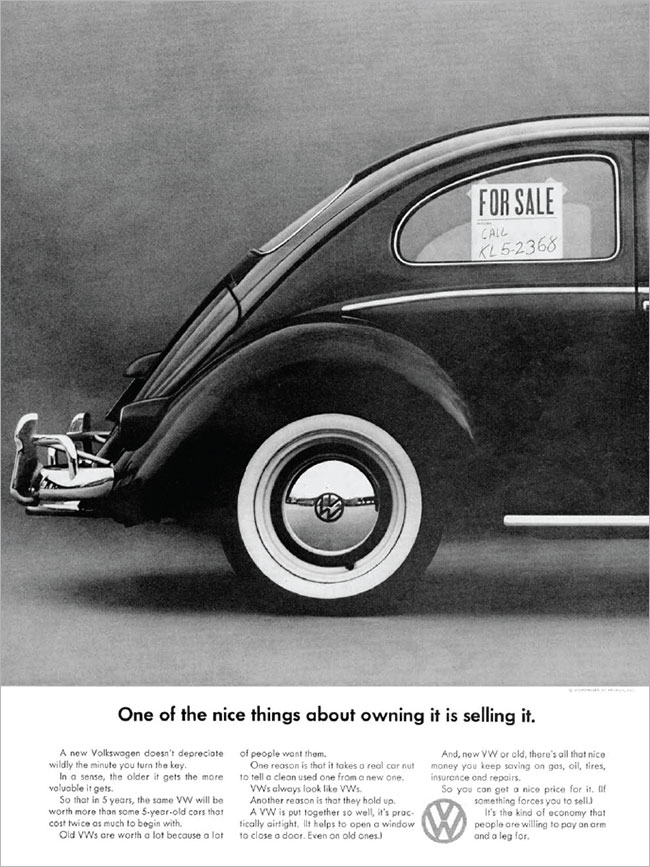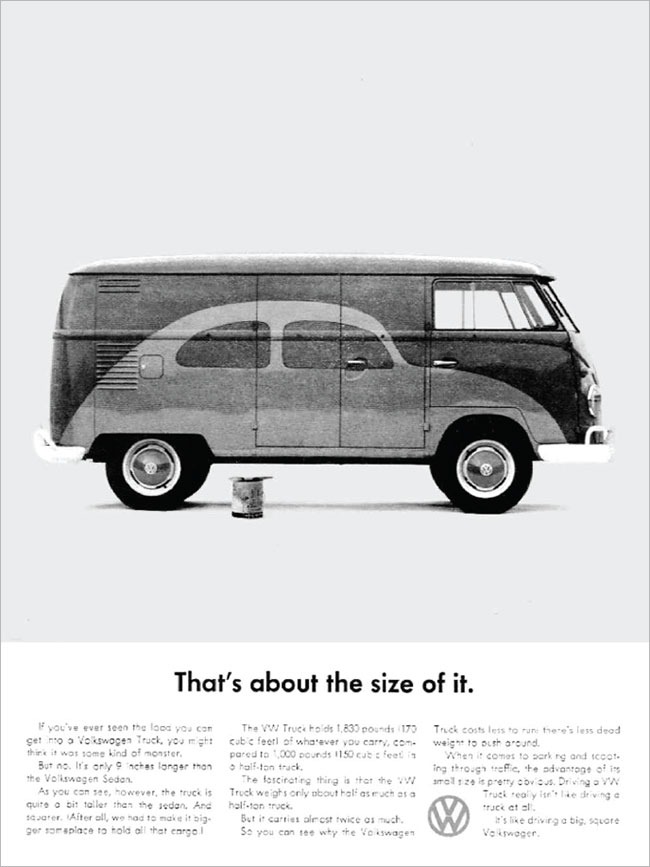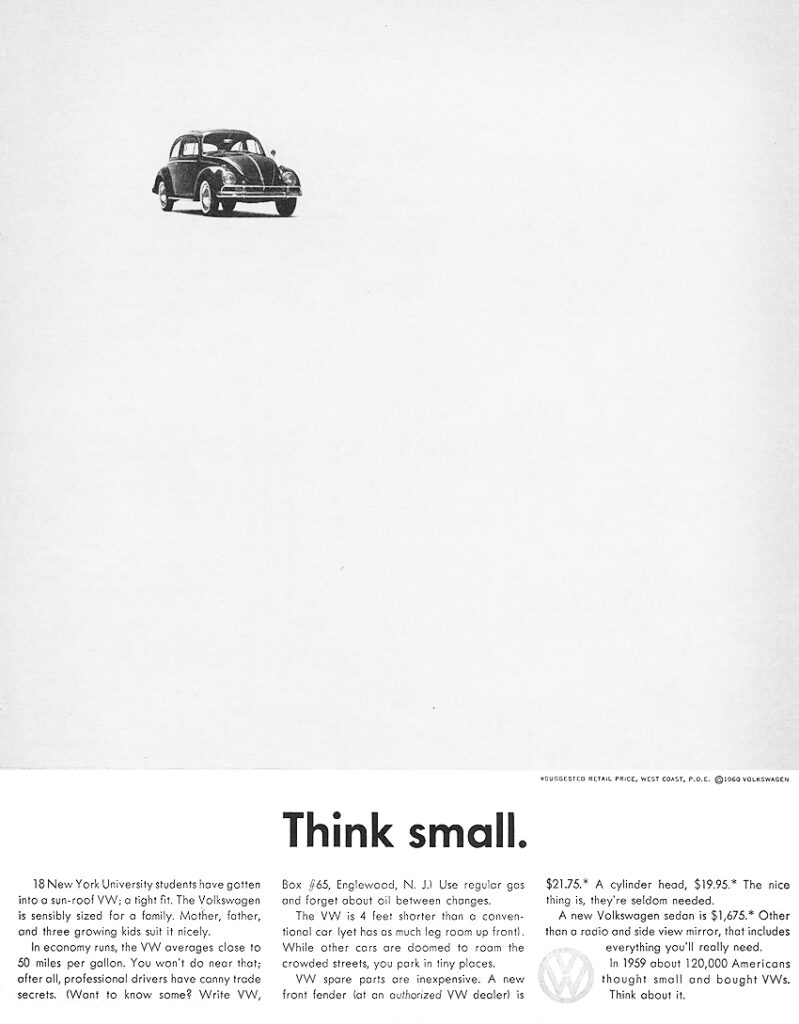
Bernbach was a pioneer of print advertising and is credited with creating the modern advertising campaign. He understood that advertising didn’t always push to sell a product, and instead created campaigns that appealed to the consumer’s emotions. This approach made him one of the most influential advertising executives of all time.
Born on August 13, 1911 in the Bronx, New York City, he was educated in the city’s public schools and graduated from New York University with a bachelor’s degree in 1932. As well as studying English and business administration, he also pursued his interests in philosophy, music, and playing the piano.
Famous Bernbach campaigns:
- Volkswagen campaings (famous ads: “Think Small” and “Lemon”)
- Juan Valdezcampaign
- We Try Harder for Avis Rent a Car System
- Mikey for Life Cereal
- You Don’t Have to be Jewish to Love Levy’s for Levy’s Rye Bread
- It’s so simple for Polaroid.
1949, Ned Doyle, Maxwell Dane & Doyle Dane Bernbach (DDB)
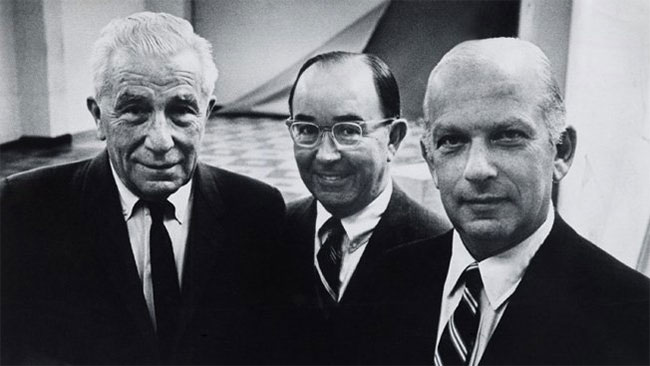
The advertising firm Doyle Dane Bernbach was founded in 1949 in New York City by William Bernbach, Ned Doyle and Maxwell Dane.
They were responsible for creating the iconic 1950s and 1960s Volkswagen advertisements that changed the history of automobile advertising.
Rather than trying to get people who didn’t want the product to buy it, the strategy was to keep people by making them brand ambassadors and caring for them.
Bob Gage lead William Bernbach’s team of creatives back then. In 1954, he hires an art director by the name of Helmut Krone, and he worked there for a few years.
Volkswagen campaigns.
Because of the “geometric simplicity” of the Volkswagen Beetle, it was “a perfect canvas on which to create a set of ideas” for both Krone and Julian Koenig who was the first copywriter on the project.
Krone also took advantage of the Beetle’s compact size and flat design to create a series of one- and two-page spreads, showing the Beetle as an everyman’s car.
We see the style of agency principal David Ogilvy of Ogilvy and Mather being adapted also for Volkswagen.
In this situation, the art director can play up the simplicity of the product and the pure, modern beauty of the car.”
Krone’s copy and ads, “all in black and white, are distinguished by a spareness of line, a lack of ornamentation, and a disregard for the ordinary.”
He made the ads “incredibly tight, clean, and spare” to communicate the “essence” of the car.

His ads were considered the “most perfect” and “most understated” of the time.
For Volkswagen, Krone combined black-and-white photographs with Bob Gage’s distinctive style for Ohrbach’s campaign in their print advertising to create a stark and powerful set of memorable images.
No retouch, raw. It allowed DDB to stand out from other agencies in the industry who used more conservative and traditional techniques for print advertisements.
The Volkswagen series of advertisements were voted the No. 1 campaign of all time in Advertising Age’s 1999 The Century of Advertising.
Each ad was designed to be so complete that it could stand alone as a viable advertisement, even without addressing all aspects of the automobile. Research by the Starch Company showed that these Volkswagen advertisements had higher reader scores than editorial pieces in many publications.
An effect of the campaign’s overwhelming success came as research by the Starch Company. It found that these Volkswagen marketing messages dominated editorial pieces in many publications, despite the fact that Volkswagen advertisements frequently had no real message, slogan or hint and just a subdued logo.
Krone doubted the power of logos, and there is some indication that their presence resulted from a conflict with the client.
In Advertising Age’s 1999 The Century of Advertising, the Volkswagen cycle of advertising (including the 1959 “Think Small” ad) were selected the best of all time.
Think Small (1959)
A legendary example. Considered a breakthrough in advertising.
Lemon (1960)
The”Lemon” left a lasting influence in America—”Lemon” identified low-quality automobiles.
The ad popularized the phrase “We pluck the lemons, you get the plums.”
Ohrbach’s (1945 -49)

Survey shows that New Yorkers think Ohrbach and Macy’s are the two stores with the most advertising budget. Ohrbach’s spends a lower percentage of sales for advertising than any other department store. Ohrbach’s ad agency’s billings at an annual rate of millions.
Mr. Bernbach’s reputation on and off Madison Ave is based on his creative approach to advertising. The Ohrbach campaign has built a character for the store at far less money than is normally spent.
While we think this ad is pretty cool, we chose it for a number of reasons, not the least of which is that it represents the image of a cat with a hat is actually a pretty old one and this ad was part of an ad campaign.
Mr. Ohrbach, the holder of the famous store, was out to change his advertising force, Grey, and encouraged Bernbach to found his own.
Avis (1962)
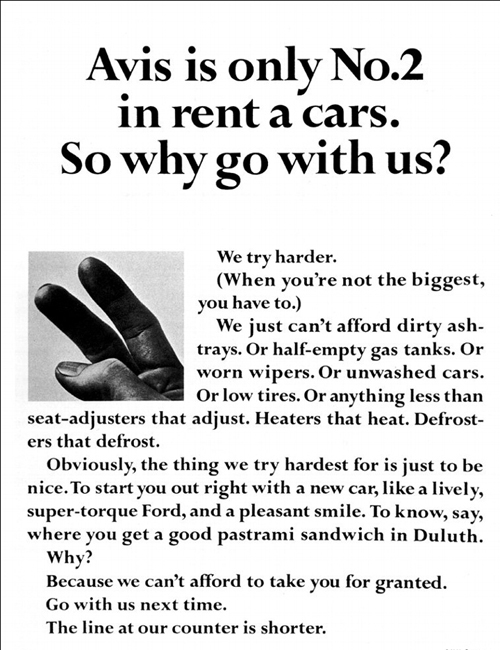
Bernbach’s Avis Rent-a-Car campaign successfully pioneered “underdog advertising” and was an immediate commercial success.
It launched in 1962, at a time when Avis was losing market share to close competitor Hertz, and it invested in the company and it did grew from deficit to profit in a single year. One of advertising’s most lasting efforts, the marketing slogan has stayed constant for 50 years.
This commercial is the topic of Craftsmen of Creativity episode 4. In it the viewer accompanies a bright, aspiring copywriter – Paula Green – on a quest to explore the spirit of an ad that prevails in time, but would turn for business in bad shape.
Avis president, Robert Townsend, had a great deal of admiration for Bernbach ‘s agency and work. He describes it as radically innovative.
Robert Townsend realized the inertia of genius and famously said, ‘whatever you produce, we’ll go with.’
A blank check is every creative’s fantasy. Avis embarked on a “We Try Harder” trip throughout the United States, emphasising to every employee that the destiny of the firm was in their control.
Levy’s (1961-70)

What a catchphrase. Judy Potras, the author, was quoted in the New York Times in 1979 as stating, “We had a local bread, authentic Jewish bread, that was marketed extensively in Brooklyn to Jewish people.” What we hoped to do was to broaden its popular acceptability. We opted to disseminate the message in this manner since New York is so racially diverse.”
The advertisements were distributed throughout New York City’s subway system and grew so popular that I later sold them as individual posters.
Fahrvergnügen (1990)
“Fahrvergnügen” translates to “driving enjoyment” and was coined by the German giant Volkswagen in a 1990 U.S. campaign that featured a stick figure cruising a Volkswagen. The word is a neologism (compound noun) thought of for this campaign, rather than being any real traditional German.
This is a legendary tagline: “Fahrvergnügen: It’s what makes a car a Volkswagen”.
Selection of Bernbach’s quotes
- “A great ad campaign will make a bad product fail faster. It will get more people to know it’s bad.”
- “More and more I have come to the conclusion that a principle isn’t a principle until it costs you money.”
- “Be provocative. But be sure your provocativeness stems from your product. You are not right if in your ad you stand a man on his head just to get attention. You are right if you have him on his head to show how your product keeps things from falling out of his pockets.”
- “An important idea not communicated persuasively is like having no idea at all.”
- “You cannot sell a man who isn’t listening.”
- “The purpose of advertising is to sell. That is what the client is paying for and if that goal does not permeate every idea you get, every word you write, every picture you take, you are a phony and you ought to get out of the business.”
- “The most powerful element in advertising is the truth.”
- “Don’t confuse good taste with the absence of taste.”
- “Just because your ad looks good is no insurance that it will get looked at. How many people do you know who are impeccably groomed … but dull?”
- “When we started our agency, we had in mind precisely the kind of people we wanted with us. There were two requirements: You had to be talented and you had to be nice. If you were nice but without talent, we were very sorry, but you just wouldn’t do. We had to ‘make it.’ And only great talent would help us do that. If you were a great talent, but not a nice person, we had no hesitation in saying ‘No.’ Life is too short to sacrifice so much of it, to living with a bastard.”
- “If you stand for something, you will always find some people for you and some against you. If you stand for nothing, you will find nobody against you, and nobody for you.”
- “All of us who professionally use the mass media are the shapers of society. We can vulgarize that society. We can brutalize it. Or we can help lift it onto a higher level.”
- “Most readers come away from their reading not with a clear, precise, detailed registration of its contents on their minds, but rather with a vague, misty idea which was formed as much by the pace, the proportions, the music of the writings as by the literal words themselves.”
- “There are few things more destructive than an unsound idea persuasively expressed.”
- “Rules are what the artist breaks; the memorable never emerged from a formula.”
- “Advertising doesn’t create a product advantage. It can only convey it.”
- “However much we would like advertising to be a science — because life would be simpler that way — the fact is that it is not. It is a subtle, ever-changing art, defying formularization, flowering on freshness and withering on imitation; where what was effective one day, for that very reason, will not be effective the next, because it has lost the maximum impact of originality.”
- “Getting your product known isn’t the answer. Getting it WANTED is the answer.”
- “Our job is to sell our clients’ merchandise … not ourselves. Our job is to kill the cleverness that makes us shine instead of the product. Our job is to simplify, to tear away the unrelated, to pluck out the weeds that are smothering the product message.”
- “Nobody counts the number of ads you run; they just remember the impression you make.”
- “It is ironic that the very thing that is most suspect by business, that intangible thing called artistry, turns out to be the most practical tool available to it. For it is only an original talent that can vie with all the shocking news events and violence in the world for the attention of the consumer.”
- “An idea can turn to dust or magic, depending on the talent that rubs against it.”
- “It is insight into human nature that is the key to the communicator’s skill. For whereas the writer is concerned with what he puts into his writings, the communicator is concerned with what the reader gets out of it. He therefore becomes a student of how people read or listen.”
- “Let us prove to the world that good taste, good art, and good writing can be good selling.”
- “The truth isn’t the truth until people believe you, and they can’t believe you if they don’t know what you’re saying, and they can’t know what you’re saying if they don’t listen to you, and they won’t listen to you if you’re not interesting, and you won’t be interesting unless you say things imaginatively, originally, freshly.”
- “It may well be that creativity is the last unfair advantage we’re legally allowed to take over our competitors.”
- “Is creativity some obscure, esoteric art form? Not on your life. It’s the most practical thing a businessman can employ.”
- “There is no such thing as a good or bad ad in isolation. What is good at one moment is bad at another. Research can trap you into the past.”
- “Properly practiced creativity can make one ad do the work of ten.”
- “Imitation can be commercial suicide.”
- “We are so busy measuring public opinion that we forget we can mold it. We are so busy listening to statistics we forget we can create them.”
- “Our job is to bring the dead facts to life.”
- “Adapt your techniques to an idea, not an idea to your techniques.”
- “The difference between the forgettable and the enduring is artistry.”
- “In communications, familiarity breeds apathy.”
- “The real giants have always been poets, men who jumped from facts into the realm of imagination and ideas.”



